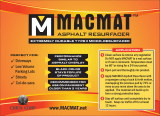
RESTORE 10X Advanced Resurfacer – Tips & Application Instructions
Page 2 of 5
other organic growth use a diluted solution of household bleach (3 parts water to 1 part bleach) applied to the
surface before cleaning. Loose paint needs to be scraped and removed from the surface.
Step 2 – Light Repairs:
Raised nail heads and/or screws should be secured using a hammer or a screwdriver. Remove loose splinters and
replace severely damaged or rotting boards. Fill larger cracks using RESTORE CRACK FILLER or a similar acrylic,
non-silicone filler. Allow to dry.
Step 3 – Apply Restore Deck Start Wood Primer:
Using a 3/8” nap roller or a synthetic bristle brush, saturate and apply generously in a consistent pattern. Work to
a wet edge at all times. Apply thickly to the surface to ensure good penetration. Restore Deck Start Wood Primer
appears milky during application but dies clear. Allow the primer to dry 1-2 hours before applying the solid
topcoat over the primer. Do not apply the topcoat until the entire primed surface is clear and there are no white
areas showing anywhere on the deck, including in cracks and nail heads.
METHOD 2: PREPARATION WITH RESTORE DECK STRIPPER
Step 1 – Remove existing Stain/Sealer:
Previously applied coatings need to be removed for two very important reasons; first stains do not adhere well to
one another and second the old finish will block the new finish from penetrating the wood. If the old stain or
sealant is peeling, it will pull your new coating up as well. The new topcoat will not lock down and seal the old
topcoat. Even if you have not recoated your deck in many years and it looks like there is no stain or sealant left on
the deck, you must complete this step. Previously applied stains and sealants may be present on the deck and are
not always visible and they will prevent the new topcoat from properly adhering to the wood.
Strip the surface using a deck brush and the Restore Deck Stripper. Apply the deck stripper to the deck and scrub it
into the wood with a deck brush. Let it sit for 15 minutes, then power wash it off completely. Follow all of the
instruction on the back of the Restore Deck Stripper label before proceeding. Next sand the entire deck using 50 or
60 grit sand paper. This will open the pores of the wood and create a textured surface that is easier for the coating
to adhere to.
Step 2 – Clean:
Clean the surface using a deck brush and the Restore Deck & Concrete Cleaner. The surface must be completely
clean and free of dirt, grease, mildew and organic growth to ensure product bonding and adhesion. For best
results use a pressure washer, in addition to the Restore Deck & Concrete Cleaner, to remove embedded dirt and
grime. (Use at a low setting 500-1200 PSI. Do not use high pressure as it may harm the wood.) For mildew and
other organic growth use a diluted solution of household bleach (3 parts water to 1 part bleach) applied to the
surface before cleaning. Loose paint needs to be scraped and removed from the surface.
Step 3 – Test Surface for Application:
AFTER CLEANING THE SURFACE YOU MUST CONDUCT A SPLASH TEST TO ASSURE THE OLD COATING IS FULLY
REMOVED FOR PROPER ADHESION OF THE NEW TOPCOAT. PREVIOUSLY APPLIED SEALERS may be present on the
deck and are not always visible. Conduct a splash test by sprinkling water on multiple areas of the surface. Check
at least 4 areas, or more for larger areas. Be sure to check both high traffic areas such as walkways and non-traffic
areas. If the water absorbs rapidly into the surface, the surface is ready to be coated. If the water beads, puddles
or is not absorbed, the surface is sealed and not ready to coat. If any part of the surface is not absorbing the
water, use the Restore Deck Stripper and Sand using 50 or 60 grit sand paper again in that section. Clean again
with a brush and Restore Deck & Concrete Cleaner and conduct the splash test again. Continue this process until
the water is absorbed by the wood in all test areas. Let the surface dry completely before application. Failure to
follow this process will result in poor adhesion and possible coating failure.











